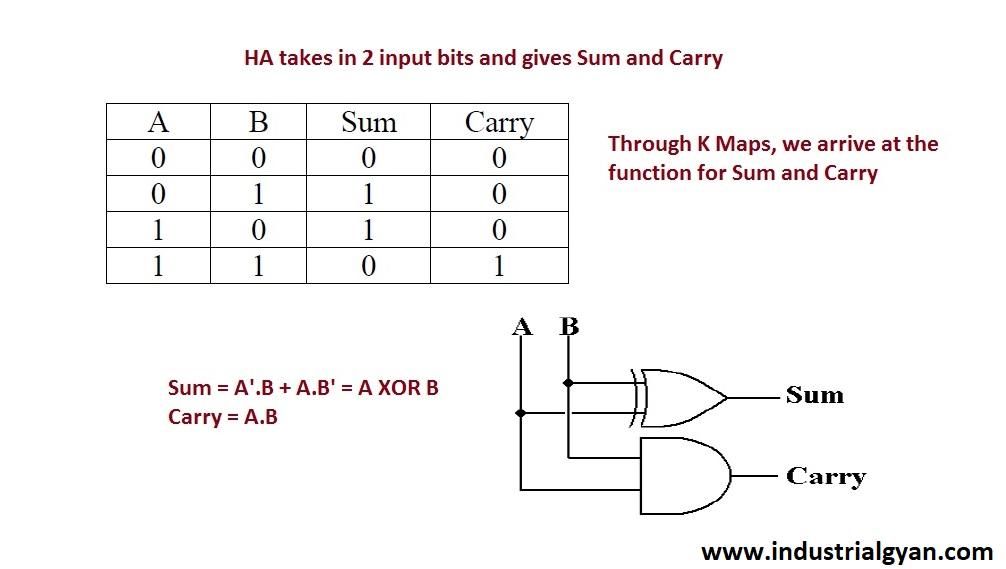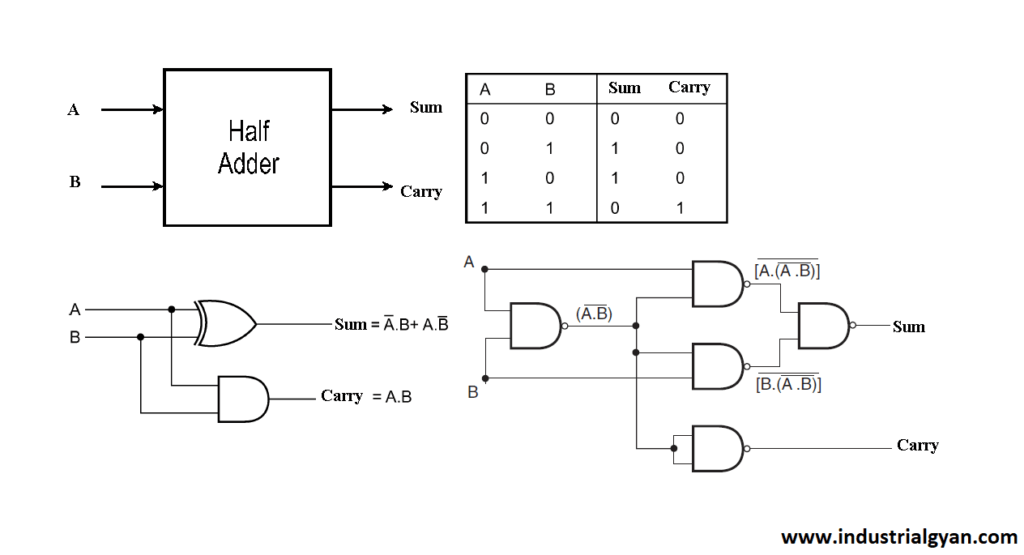Introduction
A half-adder in digital electronics performs basic arithmetic operations. It adds two single-digit binary numbers and produces their sum and carry. One common way to implement a half adder utilizes NAND gates, which are versatile logic gates extensively used in different digital systems. This article will provide an overview of a Half Adder Using NAND Gate circuit constructed using NAND gates, discussing its functionality and construction.
Outline
- Introduction
- Understanding Half Adders
- Definition and Purpose
- Binary Addition
- Half Adder Circuit
- Overview
- Truth Table
- Construction using NAND Gates
- Functionality
- Sum Output
- Carry Output
- Advantages of Using NAND Gates
- Conclusion
- FAQs (Frequently Asked Questions)
- What is the purpose of a half-adder?
- Can a half-adder handle more than two inputs?
- What happens if the inputs to a half-adder are not binary?
- Are there alternative implementations of a half-adder?
- Can a half-adder be used in complex arithmetic operations?
Understanding Half Adders
Definition and Purpose
A half-adder is a digital circuit used to add two binary digits together. It takes two input bits, performs the addition operation, and produces two outputs: the sum and the carry. The sum represents the result of the addition, Half Adder Using NAND Gate while the carry indicates whether there was a carry-over from the addition.

Binary Addition
Binary addition is a fundamental operation in digital systems. It follows the same principles as decimal addition but is performed using only two digits: 0 and 1. The addition table for binary digits is as follows:
Half Adder Circuit
Overview
The half-adder circuit consists of two inputs (A and B) and two outputs (Sum and Carry). The binary digits to be added are represented by the inputs, and the result of the addition is represented by the outputs in a half adder that uses NAND gates. The circuit uses logic gates to perform the addition operation.
Truth Table
To understand the behavior of a half-adder, let’s examine its truth table:
| A | B | Sum | Carry |
|---|---|---|---|
| 0 | 0 | 0 | 0 |
| 0 | 1 | 1 | 0 |
| 1 | 0 | 1 | 0 |
| 1 | 1 | 0 | 1 |
The truth table shows the output values of the Sum and Carry based on the input combinations.
Construction using NAND Gates
NAND gates are versatile logic gates that can be used to construct various digital circuits. A half-adder can be implemented using NAND gates. Here is the circuit diagram:

Functionality
Sum Output
The Sum output represents the result of the binary addition. It is obtained by performing the XOR (exclusive OR) operation on inputs A and B. If both inputs are different, the Sum will be 1; otherwise, it will be 0.
Carry Output
The Carry output indicates whether there was a carry-over from the addition. It is obtained by performing the logical AND operation on the inputs A and B. If both inputs are 1, the Carry will be 1; otherwise, it will be 0.
Advantages of Using NAND Gates
Using NAND gates to construct a half-adder offers several advantages. Firstly, NAND gates are readily available in integrated circuit form, making them easily accessible for circuit design. Secondly, NAND gates have a versatile nature, allowing them to be used in various digital logic applications. Lastly, using NAND gates can help reduce the overall component count and complexity of a circuit.
Conclusion
In conclusion, a half adder using NAND gates is a fundamental circuit used for binary addition in digital systems. By utilizing the properties of NAND gates, it becomes possible to construct a compact and efficient circuit that can add two binary digits together. Understanding the functionality and construction of a half-adder is crucial for building more complex digital systems.
FAQs (Frequently Asked Questions)
- What is the purpose of a half-adder?
A half-adder is used to add two binary digits together and produce their sum and carry. snubber circuit
- Can a half-adder handle more than two inputs?
No, a half-adder is specifically designed to handle only two inputs.
- What happens if the inputs to a half-adder are not binary? The inputs to a half-adder must be binary digits (0 or 1). If non-binary inputs are used, the circuit may produce unexpected results.
- Are there alternative implementations of a half-adder? Yes, there are alternative implementations of a half adder, such as using different combinations of logic gates like XOR, AND, and OR gates.
- Can a half-adder be used in complex arithmetic operations?
A half-adder is a basic building block for more complex arithmetic operations. It can be combined with other circuits to perform larger additions or used as a component in multi-bit adders.
You can Follow us on LinkedIn

I am a highly motivated and skilled individual with a passion for Electrical engineering. I have 1 year of experience in Robotics and Electrical engineering, which has allowed me to develop a strong set of skills in PLC, Painting Robots, SCADA. I am a quick learner and am always looking for new challenges and opportunities to expand my knowledge and skills. I am a team player and enjoy working with others to achieve a common goal. Successfully completed many projects for a various clients in the automobile sector.
Thank You

